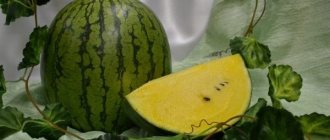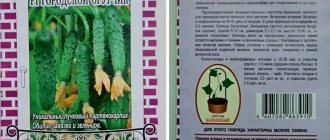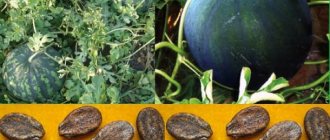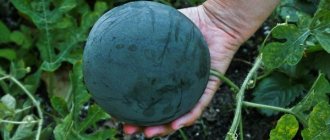Exotic plants appear in our gardens and vegetable gardens every now and then, turning from outlandish to ordinary inhabitants. The newcomer we will talk about today cannot compare in popularity with its fellow countrymen - potatoes, corn and tomatoes - but it has found its niche in gardening culture. Melotria rough is a plant whose pedigree we will deal with.
Melotria rough, also known as African cucumber, zeneria, etc.
What kind of plant is this?
Melothria scabra belongs to the genus Melothria of the Cucurbitaceae family. This is a perennial vine grown for its miniature fruits that taste similar to ordinary cucumbers. The plant is not known to all gardeners, but it has many “folk” names - the climbing vine is often called mouse watermelon, sour gherkin, Mexican cucumber.
Botanical description
The plant is very similar to ordinary cucumbers, but the leaves, flowers and fruits have slight differences. Brief botanical description of “mouse melon”:
- Leaves. The shape of the leaves is similar to cucumber, but they are slightly smaller in size. The surface of the leaves is rough - that is why the name of the plant contains the word “rough”. The leaves are three-segmented, triangular, all segments are pointed.
- Fruit. They are small, growing up to 4 cm in length. They are collected in an immature state, when their length reaches 2 cm. The surface of the fruit is spotted and striped, so they look like miniature watermelons. The fruits are edible; their taste combines notes of cucumber with the sour taste of melon peels.
- Tubers. They resemble the shape of sweet potato tubers. Weight – up to 400 g. Edible, taste – a mixture of radish and cucumber.
- Mustache. Thanks to the long and tenacious mustache, the plant is attached to any support. For weaving, pergolas and trellises are installed - the plant completely entwines them.
- Flowers. The plant blooms in June. The flowers are bright yellow, bisexual. The female ones bloom one at a time, the male ones are collected in inflorescences. The flowers have a pleasant, unobtrusive scent that attracts pollinating insects.
The plant is actively growing - its vertical shoots grow upward, clinging to the supports. They reach a length of 3 m. Side shoots, lying on the ground, are able to take root reliably.
The peculiarity of melotria is that female flowers bloom earlier than male ones.
Origin
Melotria was first described in the 19th century by the French botanist Sh.V. Noden. Modern botanists question the classification of the plant made by him - closely related species have been discovered in Africa, and the differences between the vines have not yet been identified.
Some sources claim that the homeland of melotria is equatorial Africa. Others attribute a connection to the vine with central America, and they are right - this is where the vine comes from. Melothria has nothing to do with Africa, and “African cucumber” is nothing more than another “folk” name that has no scientific basis. In fact, the birthplace of this unusual plant is the Central American region.
Spreading
In Central America, melotria is perceived as a weed. In fact, it is just that - a weed that does not require any care and can withstand various weather troubles. The main condition is warmth; melotria can grow in any region of Russia, but it does not tolerate cold. In the central regions and further north, it is grown only by seedlings.
In its homeland, melotria is a perennial. For us, it becomes an annual, as it freezes in winter. In the tropics there are no sub-zero temperatures, but in Russia, even in the southern regions, it drops below zero.
In Mexico, melotria manifests itself as an aggressive weed - it reproduces not only by seeds, but also by tubers. It is extremely difficult to lime it; if it starts, it will sprout again next year. In Russia, with its winters, such problems do not arise.
Fruiting and productivity
Fruiting occurs quickly. Already two weeks after planting the seedlings, you can see the first “watermelons”. Flowering and fruiting occur in June. The plant produces a lot of fruits - they are formed in each node, and fruiting is extended over time. If you take care of melotria, it will bear fruit until frost. Its yield reaches 5 kg per bush.
We offer you to watch a video in which gardeners share their impressions of the unpretentiousness of Melotria.
What does melotria look like?
Like many climbing vines, melotria forms a thick green mass that looks very decorative. The length of the vines reaches 3 m, so the crop is good for vertical gardening using trellises, pergolas and arches. Planted near any building, melotria can improve an old barn, transform a gazebo or decorate the wall of a house.
The leaves of this vine are moderate green, triangularly dissected and rough, very similar to cucumber leaves. Melotria clings to any support with its tendrils, but requires garter: the lashes can fall off under the weight of numerous, heavily leafy side shoots.
The first thing that strikes a gardener is the incredibly abundant flowering. The plant is literally strewn with small bright yellow flowers, the female ones growing separately, and the male ones collected in bunches. Plant an exotic liana in your area and all the bees will be yours: these insects love melotria, so the fruits are 100% set.
Varieties of melotria rough
Melothria has long been domesticated, but very few varieties have been bred. All varieties have fruits approximately 3 cm long, the color of all is almost the same, with slight deviations. In the West, companies selling seeds do not indicate varieties of melotria. But from Russia there are several varieties of rough “Mexican cucumber”; let’s look at the most famous ones.
Hummingbird
This variety does not look any different from Melothria scabra. Therefore, doubts arise as to whether the originator is really selling a variety that is different from the wild plant. The description and agricultural technology of "Hummingbird" correspond to the usual Melotria rough. Of all the varieties, only “Hummingbird” is registered in the State Register.
Stores often offer melotria without specifying the variety. At the same time, on the nameless bags they write a description that belongs to “Kolibri”:
- shoot length – 3 m;
- average yield - 3-3.5 kg per plant;
- 40 days pass from the moment of germination to the first fruits;
- fruit size is 2-3 cm.
Unregistered varieties
You can also find melotria on sale under the following names:
- Mini cucumber. The name itself indicates the “nationality” of the “variety” being represented. These are not cucumbers, not gherkins, but a completely different plant. Agricultural technology - like cucumbers, but without pinching shoots.
- Chapiteau. The botanical description corresponds to Melotria rough - what the features of the “variety” are is unclear. You can plant landscaping on balconies, gazebos, and fences. You should check with the sellers whether the species is edible or not.
- Baby. Fruit size – 3cm. the same as that of ordinary melotria. Sellers do not indicate any varietal characteristics.
- Mouse melon. This type does not exist at all. This is just the “folk” name for melotria rough. Nevertheless, you can find packages on sale that say “mouse melon.” In fact, this is ordinary melotria.
Melotria Calibri Seeds
Melotria Seeds Mini Cucumber
Seeds of Melotria Shapito
Melotria Malyutka Seeds
Melotria Mouse Melon Seeds
Melotria recipes
The berries of this vine almost completely replace cucumbers in taste and smell, so there are no special recipes for Melotria rough. It is used in the same place where cucumbers are used. Melotria rough preparations for the winter are also made according to the “cucumber” recipe. The same goes for salads, pickling or jam.
The advantage of this berry is that children really like small “watermelons”. Children should not be forced to eat these fruits. Children often eat them on the spot, tearing them off the vine.
Important! Ripe fruits are better suited for preserving Melotria rougha.
Melotria pickling recipe
Every family has marinade recipes for any product. You can try different ingredients and proportions. In the case of melotria rough, it is enough to choose one of those marinades that are suitable for cucumbers:
- 1 kg of fruits;
- 2 bay leaves;
- 2 dill umbrellas with seeds;
- 5 cloves of garlic;
- ½ pod of hot pepper;
- a teaspoon of vinegar essence;
- 70 g salt;
- 100 g sugar.
Rinse the fruits, garlic, bay and dill thoroughly and pour over boiling water. Place in sterilized jars, add salt and sugar. Pour boiling water and wait until the salt and sugar dissolve. Drain the brine and boil again. Fill the jars again and add vinegar. Close the lids tightly.
Salting melotria
Open pickling is again borrowed from cucumbers. The fruits are poured with brine, to which salt, vinegar and sugar are added to taste. Garlic, black pepper, dill root, and other spices are added for flavor. This product is intended for quick consumption, as there is no sterility.
Melotria jam
The recipe for making jam is again borrowed from the cucumber crop, and the technique from the gooseberry. Young fruits are used for jam. The rough melotria does not need to be peeled; there is too little pulp and a lot of water underneath. Jam is made from whole fruits. You can prick them with a needle, like gooseberries.
Ingredients:
- mouse watermelons 500 g;
- 1 lemon;
- 1 orange;
- cinnamon stick;
- star anise;
- 2 boxes of cardamom;
- 300 g sugar;
- vanilla to taste.
Cut the orange into cubes and remove the seeds. Juice is squeezed out of the lemon. All ingredients are placed in a saucepan, a little water is added and put on fire. After the liquid boils, reduce the flame and cook until thickened for 40-50 minutes.
Advantages and disadvantages
Advantages of “mouse watermelon”:
- The leaves, unlike cucumber leaves, do not dry out or turn yellow - they remain green until late autumn. Therefore, the plant can be used for decorative purposes.
- Suitable for decorating vertical and horizontal surfaces at the same time.
- The plant not only grows beautifully on mesh, twine, wire, trees, but it grows well in separate containers. Melothria can be planted in boxes, containers, pots - it is suitable for landscaping balconies and other places where the plant cannot be planted directly in the ground.
- Disease resistance.
- High yield.
- The versatility of fruit use.
- Unpretentiousness and low maintenance requirements.
The disadvantages include the following:
- The plant is not immune from diseases and pests of melon crops.
- Melotria fruits and tubers are practically not stored - they need to be eaten fresh.
The aggressiveness of melotria does not manifest itself in the climate of the Russian Federation. Perhaps there may be complaints about insufficient decorativeness and imperfect taste of fruits and tubers, but these are subjective assessments.
Possible harm and contraindications
The unpretentiousness of the plant and its rapid growth, uncontrolled by the owner, can harm neighboring plants, stopping their development. Melotria rough has a lot of benefits and does not bring much harm, but the fruits should be consumed in moderation. If taken uncontrolled, an uncomfortable condition in the form of diarrhea may occur.
The fruits of the plant should be taken with caution by people with chronic diseases and should not be abused by children.
Contraindications for the use of drugs from melotria are:
- All diseases of the gastrointestinal tract;
- Insufficiency of cardiac activity (defects);
- Breastfeeding and pregnancy;
Planting melotria
Melotria can be sown in open ground, or you can first grow seedlings and then transplant them to the site. The second method is used in regions with short summers. The seedling method allows you to get the harvest a little earlier than when sowing in open ground.
Seed method
Sowing seeds in the ground is usually used in two cases:
- if the landing is made in the southern region;
- if melotria is used as an ornamental plant and fruiting is not the key task of the plant.
In temperate climates, melotria seeds are sown in the second ten days of May. Sowing order:
- make a small furrow in a pre-dug and fertilized area;
- 2 seeds are planted at intervals of 20 cm;
- fill the furrow with moistened soil and cover it with a board.
Planting seedlings
In Russia, melotria grows as an annual, and the best way to grow it is from seedlings. Sowing the seeds coincides with the timing of ordinary cucumbers. Seeds for seedlings are sown in early April.
The procedure for growing seedlings:
- Prepare boxes or containers. They are filled with substrate, which is watered abundantly immediately before sowing.
- Melotria seeds are similar to cucumber seeds, but they are very small - it is better not to cover them with soil. The best option is to pour them onto the substrate and then cover them with material that transmits light - glass or film. The crops are placed in a warm room.
- Shoots appear after 2-3 days. After the appearance of the third true leaf, the seedlings are planted in separate pots - 2-3 pieces in each.
- A week later, the seedlings are given complex fertilizer.
- Caring for seedlings involves regular watering. The soil should not be over-watered.
- Seedlings are planted in open ground in mid-May. It tolerates transplantation well and takes root quickly. If there is a risk of return frosts, the plantings are covered with film. The distance between neighboring plants is at least 40 cm.
Before planting, it is recommended to harden the seedlings so that they can withstand unusual temperatures. Seedlings are accustomed to the street gradually - by taking them out into the air for several hours or opening a window for ventilation if the seedlings are growing in the house.
Landing place
Question one: where to plant melotria. Like most pumpkins, this crop loves the sun, so for decorative landscaping they choose the southern or southwestern walls of buildings. It is better to place arches or pergolas in an open space; you can even build a support like a wigwam, which will create a wonderful element of landscape design.
Do not make the mistake of planting climbing vines in greenhouses and greenhouses with other crops. It will reign there and mercilessly kill the neighboring plants. In open ground, rough melotria grows well and in any case will produce a harvest, because it bears fruit until frost.
Theoretically, this vine can be grown on a balcony or loggia. However, in a cramped room, the plant will have to be shaped by constantly pinching out numerous side shoots and the central stem.
Rules of care
The liana is quite comfortable growing and bearing fruit in the climate of the middle zone, especially since there are no problems in the southern regions. Caring for melotria is easy:
- Like all pumpkin plants, it loves frequent and abundant watering. The main thing is to avoid stagnation of water and waterlogging of the soil.
- After watering, the soil is loosened, but not deeply, so as not to damage the root system. To retain moisture and prevent the growth of weeds, the beds are mulched.
- To increase productivity, plants are fed with fertilizers.
If a plant is planted not for its fruits, but for decoration, it is fed with nitrogen fertilizers at the initial stage of the growing season. Nitrogen promotes the growth of green mass. If you are interested in the harvest, apply complex fertilizers, which are dominated by potassium and phosphorus.
- Supports and nets for weaving are prepared in advance for the vine.
- To prevent powdery mildew, the plant is sprayed with a soap solution 2 times during the season. To prepare the composition, use tar or laundry soap.
If melotria grows well, does not get sick, and has a lot of green mass, it becomes an effective element of landscape design. Unlike other pumpkin plants, the foliage of the vine does not turn yellow, does not wither or wither - it remains attractive until the coldest weather.
The leading role of fertilizing and watering
An exotic crop needs enough water, so the planting is watered abundantly and often. According to some studies, up to 10 liters of liquid are added per specimen. Before water procedures, it is advised to thoroughly loosen the soil so that the earth can absorb moisture like a sponge. At the same time, it is important to remove weeds from the garden bed in a timely manner, as well as feed melotropia.
Fertilizers are applied 2 times per season:
- At the first stage of growing watermelon cucumber. Nitrogen-containing mixtures are laid out in the planting, which stimulate the growth of green mass.
- During the period of setting inflorescences. Phosphorus and potassium fertilizers are used for their formation, development, and further growth. Mineral complexes are used every 10 days until harvest.
To protect vegetation from powdery mildew, it is recommended to spray it with a soap solution in July and August. To prepare a handy fungicide, you will need to dilute 50 g of laundry soap in 10 liters of liquid.
At home, Melotria rough does not require special care. If it is planted in light, fertile soil with a neutral or slightly acidic reaction, then you can expect abundant harvests. In such a closed space, for the development of full-fledged tubers, the distance between specimens can be reduced to 15-20 cm. In this case, the gardener will have to shape the crown of the indoor plant, regularly pruning improperly growing shoots.
Mini-cucumber inflorescences come in 2 types. The males grow in clumps of several yellow flowers. The female ones are located separately on the bush.
How to collect melotria seeds?
Overripe mini-cucumbers should not be thrown away. If you extract the seeds from them, wash them and dry them, you can get a portion of seeds for planting next year.
Features of collecting melotria seeds:
- To obtain seeds, it is best to use fruits that have fallen to the ground.
- Overripe fruits are kept for another couple of weeks - they are laid out on a baking sheet. Keep them indoors.
- After cutting the dried and wilted fruits, the seeds are removed - they are placed in a jar of water and kept for another 5 days. During this period, pathogenic microbes die, and the seeds are sorted by quality. The good ones lie at the bottom, the bad ones float to the surface.
- After 5 days, the seeds are washed and, spread on a flat, dry surface, kept in a well-ventilated area for two weeks.
- When the seeds are dry, they are transferred to a hermetically sealed container, which is then kept in a dry and cool place.
If melotria seeds are stored correctly, they remain viable for up to ten years.
Propagation by tubers
Melothria reproduces not only by seeds, but also by tubers - like potatoes. If you don’t want to wait for the seed to germinate, you can use tubers for planting. They are not stored for long as a food product, but they can be preserved as planting material. To do this, the tubers are placed in the basement in the fall. To prevent them from spoiling, they must be placed in slightly moistened peat. Tubers are planted in the spring, when the soil warms up.
Multifunctional assistant
The North American gift of the garden tastes very piquant due to the slight sourness that is “hidden” in the skin. Some national dishes include unusual fruits. But you can add them to the table only if their seeds have not yet become coarse.
You can eat mini watermelons not only after heat treatment. They are consumed raw or soaked in marinade. If the housewife is planning to make lightly salted cucumbers or preserve green tomatoes in a barrel, then adding an atypical additive to the brine is allowed at any time.
Content:
- Multifunctional assistant
- Indications and contraindications
- Culinary use
If salted melotria is served on the table as a snack for alcohol, then inexperienced guests will wonder for a long time what kind of specific color the olives have. In addition, the canned preparation goes well with winter salads and can even serve as a decoration element for the main dish, canapés.
Taking the risk of raising a guest from distant Africa on their own plot, gardeners will be able to supplement their diet with a juicy, light-colored tuber at the end of the harvest season. It tastes like radishes. It is better to eat it fresh, or adding it to salads with other vegetables. The only caution is the rules for correct storage, since the root must be eaten immediately after digging. Even deep freezing will not save it, since the nutrients quickly evaporate.
Experimenters who have started growing often leave reviews indicating another area of application for the plant. It is often used by landscape designers, creating cozy green hedges that are famous for their unpretentious care.
For decorative purposes, atypical bindweed can simply be planted in flowerpots, placing them on the window sills of the balcony. In a few years, they will make a real natural fence, creating good shade without unnecessary hassle for the owners.
In public institutions, shoots are simply launched along the wall of the hall, having made a “web” for them from ropes for reliable fastening. The result is an original decoration that does not require special care. It is enough to periodically feed the soil with organic fertilizers.
Harvesting and eating
The fruits are collected when they are slightly unripe. Do not wait until they grow to 4 cm in length and become soft. The fruits are removed when they reach a length of 2-3 cm. Neither fruits nor tubers are stored for a long time. They are immediately put into preparations, which are made according to “cucumber” recipes. They are salted, pickled, and made into jam.
It is recommended to eat the fruits fresh. Overripening, they become soft, a lot of seeds appear in them, and the taste loses its pleasantness. Mini-cucumbers are harvested for food when they are slightly unripe, while they are quite elastic.
Melothria fruits are used to prepare salads; they are also included in meat, fish and vegetable dishes. Mini cucumbers are pickled in assorted canned food, along with other vegetables. When pepper is added to the marinade, the fruits acquire an original flavor.
When the plant bears fruit, you can begin to extract the roots - they can be eaten raw, put in salads, or added to stews. But root vegetables must be used within 3-4 days, then they lose their nutritional and taste value.
Direct planting or seedlings
Question two: is it worth growing melotria in seedlings? In regions with early spring, where there is no threat of return frosts, Melotria rough seeds are planted directly into the ground at the same time as cucumbers. In cold areas, in order to harvest the first harvest early, it is better to grow seedlings 3 weeks before the intended planting in a permanent place.
There is no need to soak the seeds; now many gardeners are moving away from this practice. For planting, 200 ml cups and any nutritious soil, pre-moistened, are suitable. It is better to plant 1 seed per glass, deepening it by 1-1.5 cm.
The soil is moistened, not allowing it to dry out, but not flooded; pumpkin plants do not like this. If you put bags on the cups and place them on warm windowsills, Melotria rough shoots will appear in 3-4 days. The greenhouses are immediately removed and the plants are moved away from the radiators. If possible, take it outside on a sunny day.
In apartments with northern and eastern windows, it makes no sense to grow melotria seedlings: the plants will turn out elongated and weak. As an option, you can buy a phytolamp, but in any case, after planting in the ground, the seedlings will have to be shaded for the first time.
Benefits and harms
“Mouse watermelon” contains a lot of useful substances. Its fruit is recommended to be eaten during fasting days and during dietary nutrition. They contain a lot of magnesium, iron, potassium, phosphorus, sodium, calcium, as well as vitamins C and B9.
Benefits of melotria fruits:
- the immune system is strengthened;
- blood pressure normalizes;
- the walls of blood vessels are strengthened;
- cholesterol in the blood decreases;
- cardiac activity is stimulated;
- weight decreases and normalizes.
Having a low calorie content of 15 kcal per 100 g, “mouse watermelon” causes a feeling of fullness. Scientists have found that melotria fruits have a tonic, restorative and anti-inflammatory effect.
Despite many beneficial properties, the fruits of “mini-cucumbers” are contraindicated for people who have high acidity and gastric diseases - gastritis, stomach ulcers and others.
Miniature “watermelon-cucumbers” should not be eaten by pregnant women. Hypertension, cardiovascular diseases, liver, kidney and gastrointestinal diseases are also contraindications to the consumption of mini-cucumbers.
When to collect melotria and what to do with the harvest
The first fruiting of the vine causes great delight in adults and children. As people write in reviews, rough melotria suddenly began to bear fruit like crazy, and this is the true truth.
Miniature watermelons are harvested when they are 1.5-2.5 cm long; larger ones become tasteless. By the way, the marketable weight of ripe melotria rough fruits is only 10 g, and from one vine you can harvest up to 5-6 kg. The fruits are stored for 3-4 days, so it is better to consume them immediately or process them, because new ones will ripen every day.
The fruits can be pickled like ordinary cucumbers, but, as practice shows, melotria is literally created for pickling. Jars with cucumbers and tomatoes look very impressive, where all the voids are filled with tiny watermelons. And the taste of pickled melotria is incomparable!
It is important to note that each plant produces several edible tubers, weighing about 400 g, similar to sweet potato tubers. One vine produces approximately 1.5 kg of tubers, which are very good in autumn salads.
In winter, you cannot buy melotria rough in the store, so in summer, be sure to include fresh fruits in your diet, which contain a lot of useful substances.
Reviews about melotria
★★★★★
Konstantin E., amateur gardener, Kursk region. For the first time I planted “mouse watermelons” out of interest - to see what kind of vegetable they were.
I planted four bushes per meter. At first the growth was slow, then the plant quickly began to grow and covered the entire trellis near the veranda. There are a lot of fruits - small cucumbers, and I collect them before frost - there is always an ingredient for salads. Children eat “berries” straight from the vines, but I prefer them as part of various dishes and in canned form. The next year, he built strong supports for the lashes so that they would not break under the weight of the harvest. ★★★★★
Natalya F., summer resident, Krasnodar region. The plant is unpretentious and at the same time productive - ideal for summer residents.
Can be used for decorative purposes - the vines are strong, weave well, and there are many leaves, and they are always green, do not wither or turn yellow. I plant seeds in open ground, they grow without problems. Last year I collected a harvest from plants every day - about 20-25 pieces. Just enough for a salad. At the same time, melotria beautifully weaves my gazebo; I’m also thinking of planting it near the fence. Hide
Add your review
Melotria is not the most popular vegetable among our gardeners. But as a plant that combines the properties of a vine with high yields of edible fruits, it can be very attractive. Without requiring special care, the “mouse watermelon” will not only create shade on your site, but will also supply you with mini-cucumbers until late autumn.
0
0
Copy link
General information
The plant has liana-like stems reaching a length of up to 3 meters and leaf blades similar to cucumber leaves, but without roughness.
The fruits of melotria taste like cucumber and have a slight sourness. Although the surface of the fruit is a little rough, unlike a cucumber, it is not prickly. The plant's roots resemble long, white radishes in both shape and taste.
This exotic plant has won the recognition of gardeners not only due to its simple care, but also due to its invaluable benefits for the body, its fruits and roots. If you dream of growing this unusual crop in your garden, then feel free to plant it and at the end of summer you will be able to enjoy the harvest in the form of small mouse melons.
general description
Melothria is a typical representative of the pumpkin family. In the wild, it is distributed throughout Africa and Central America. Two varieties are included in the Russian state register of breeding achievements - Kolibri and Shapito. Due to earlier inclusion in the register (in 2004), Hummingbird is most common among gardeners. The tent is a new item included in the register of those admitted in 2019. Both representatives of the “rough” variety are intended for cultivation in garden plots, homesteads and small farms. According to the originator, cultivation is possible in all climatic zones.
You may be interested in:
Cucumber variety Herman f1: description and characteristics, reviews Herman F1 is a hybrid bred by Dutch breeders by crossing several varieties of cucumbers. In...Read more...
Biological features
The plant is an annual, fast-growing vine. Scourges can reach lengths of more than 3 meters. The leaf blades are triangular in shape, with sharp ends. The surface of the leaves is pubescent and rough to the touch, hence the name - Melotria rough. During the flowering period, the bush is strewn with small yellow funnel-shaped flowers. Flowering is of a mixed type: female flowers are single, male flowers are formed in axillary bunches.
The liana-like bush quickly gains green mass. The scourges are actively growing both in length and width. This feature allows the bushes to be used for vertical gardening. Due to the strong foliage and tenacious tendrils, the supports are quickly covered with greenery. The aggressiveness of vegetative growth suggests the absence of neighboring herbaceous plants.
Double Harvest
The fruiting period begins 2-3 weeks after planting a 30-day-old plant in the ground. The fruits are cucumbers 1.5-3 cm long, similar in shape to olives, and in color to mini-watermelons. Unofficially, the names assigned to the fruits are African cucumber and Mexican gherkin. The pulp of the fruit tastes like regular cucumbers. But due to the sourness from the peel, the taste of hare cabbage appears. The taste of overgrown and overripe vegetables deteriorates significantly. Mini-watermelons should be picked slightly unripe, without waiting for them to become soft.
The unusual cucumbers are edible and can be eaten fresh from the bush. The exotic harvest looks beautiful when pickled (marinated) with other vegetables. Housewives love to add “stripes” to jars of cherry tomatoes or decorate ready-made meat and fish dishes with them.
The productivity of “rough” is high. The fruiting period lasts until frost. More than 5 kg of fruit can be collected from one bush per season. In addition, at the end of the season, melotria presents another batch of harvest - an edible root vegetable. At the end of the thin root system, towards the end of the fruiting period, a white and fleshy tuber is formed. Its weight can reach 800-1000 g. The tubers taste more like sweet radishes with cucumber notes.
For information!
Melotria tubers quickly deteriorate and are not suitable for storage. Therefore, they need to be eaten in the first day or two after collection.
Melotria rough: description with photos, planting, cultivation features and care rules
- November 20, 2018
- Greens and herbs
- Natalia Egorenkova
Do you like unusual plants? Be sure to plant rough melotria in your area.
This exotic liana is ideal for vertical gardening, does not require special care and does not lose its decorative effect until frost.
Already in the middle of summer, she will thank you with a rich harvest of miniature fruits - edible and healthy, tasting like a cucumber, which will become the subject of admiration for nearby gardeners and a decoration for winter preparations.
What kind of plant is melotria?
Ask your dacha neighbors about melotria. They are unlikely to answer you what it is, although just recently crazy cucumbers or lagenaria were just as exotic, but today they are grown everywhere.
Melothria is a herbaceous vine native to the tropics of Central America, but some sources claim its African origin.
This crop belongs to the pumpkin family, and its closest relatives are cucumber, zucchini, watermelon and lesser known vines, for example, coccinia, momordica, chayote or monk fruit. By the way, on bags of melotria rough seeds, some manufacturers write this: “Mexican cucumber.”
In nature, melotria goes through a multi-year development cycle, but in temperate climates it is grown as an annual plant and even in regions of risky farming manages to please with a good harvest.
What does melotria look like?
Like many climbing vines, melotria forms a thick green mass that looks very decorative. The length of the vines reaches 3 m, so the crop is good for vertical gardening using trellises, pergolas and arches. Planted near any building, melotria can improve an old barn, transform a gazebo or decorate the wall of a house.
The leaves of this vine are moderate green, triangularly dissected and rough, very similar to cucumber leaves. Melotria clings to any support with its tendrils, but requires garter: the lashes can fall off under the weight of numerous, heavily leafy side shoots.
The first thing that strikes a gardener is the incredibly abundant flowering. The plant is literally strewn with small bright yellow flowers, the female ones growing separately, and the male ones collected in bunches. Plant an exotic liana in your area and all the bees will be yours: these insects love melotria, so the fruits are 100% set.
Melotria fruits: cucumbers in watermelon skin
Gardeners who are passionate about their hobby experience real delight when rough melotria begins to bear fruit. It should be noted that the vine grows quickly and in the middle zone gives the first harvest in July.
These are small oblong fruits, 1.5-2.5 cm long, with a dense peel and a pattern almost like a watermelon. Due to this color feature and the miniature size of the fruit, the vine is ironically called “mouse watermelon.”
In general, the fruits of Melotria rougha in the photo immediately cause a storm of emotions on gardening forums. They taste like cucumbers, but with a piquant sourness.
The fruits are eaten fresh, in handfuls, crumbled into salads, salted, pickled and used to decorate dishes.
Agree, it is worth conducting an experiment on growing melotria rough, especially since this crop is unpretentious, responsive to fertilizers and, most importantly, it rarely gets sick.
Landing place
Question one: where to plant melotria. Like most pumpkins, this crop loves the sun, so for decorative landscaping they choose the southern or southwestern walls of buildings. It is better to place arches or pergolas in an open space; you can even build a support like a wigwam, which will create a wonderful element of landscape design.
Do not make the mistake of planting climbing vines in greenhouses and greenhouses with other crops. It will reign there and mercilessly kill the neighboring plants. In open ground, rough melotria grows well and in any case will produce a harvest, because it bears fruit until frost.
Theoretically, this vine can be grown on a balcony or loggia. However, in a cramped room, the plant will have to be shaped by constantly pinching out numerous side shoots and the central stem.
Direct planting or seedlings
Question two: is it worth growing melotria in seedlings? In regions with early spring, where there is no threat of return frosts, Melotria rough seeds are planted directly into the ground at the same time as cucumbers. In cold areas, in order to harvest the first harvest early, it is better to grow seedlings 3 weeks before the intended planting in a permanent place.
There is no need to soak the seeds; now many gardeners are moving away from this practice. For planting, 200 ml cups and any nutritious soil, pre-moistened, are suitable. It is better to plant 1 seed per glass, deepening it by 1-1.5 cm.
The soil is moistened, not allowing it to dry out, but not flooded; pumpkin plants do not like this. If you put bags on the cups and place them on warm windowsills, Melotria rough shoots will appear in 3-4 days. The greenhouses are immediately removed and the plants are moved away from the radiators. If possible, take it outside on a sunny day.
In apartments with northern and eastern windows, it makes no sense to grow melotria seedlings: the plants will turn out elongated and weak. As an option, you can buy a phytolamp, but in any case, after planting in the ground, the seedlings will have to be shaded for the first time.
Planting in the ground and care
Melothria grows poorly on heavy, loamy soils, so the planting site is well dug up, and the soil can be lightened by adding a mixture of peat, humus and sawdust. When creating a hedge, plants are planted at a distance of 70 cm from each other.
Unlike many pumpkins, which take a long time to take root and get sick after planting, melotria roughens well with transplantation and after 7 days begins rapid vegetative growth. If the crop is grown for landscaping, the first fertilizing should be nitrogen-dominated. Subsequent ones are carried out 2 times a month, alternating phosphorus-potassium and organic fertilizers.
They weed the vine only the first time, then the rich green mass itself does not allow weeds to grow. The soil should be loosened carefully, preferably watered with water heated in the sun, abundantly, but infrequently.
The only disease of melotria rough is powdery mildew, an ectoparasite fungus that forms a grayish-white coating on both surfaces of the leaves. To prevent infection, it is recommended to treat plants with laundry or tar soap diluted in water twice a season.
When to collect melotria and what to do with the harvest
The first fruiting of the vine causes great delight in adults and children. As people write in reviews, rough melotria suddenly began to bear fruit like crazy, and this is the true truth.
Miniature watermelons are harvested when they are 1.5-2.5 cm long; larger ones become tasteless. By the way, the marketable weight of ripe melotria rough fruits is only 10 g, and from one vine you can harvest up to 5-6 kg. The fruits are stored for 3-4 days, so it is better to consume them immediately or process them, because new ones will ripen every day.
The fruits can be pickled like ordinary cucumbers, but, as practice shows, melotria is literally created for pickling. Jars with cucumbers and tomatoes look very impressive, where all the voids are filled with tiny watermelons. And the taste of pickled melotria is incomparable!
It is important to note that each plant produces several edible tubers, weighing about 400 g, similar to sweet potato tubers. One vine produces approximately 1.5 kg of tubers, which are very good in autumn salads.
In winter, you cannot buy melotria rough in the store, so in summer, be sure to include fresh fruits in your diet, which contain a lot of useful substances.
Useful properties of miracle vines
100 g of melotria fruits (10 pieces) contain only 14 kcal, why is this not a dietary product? Vitamins PP, A and ascorbic acid, as well as B vitamins, were found in the peel. Of the minerals that make up the peel and pulp, it is worth noting potassium, calcium, iron, sodium, fluorine, phosphorus and magnesium.
By including fresh melotria rougha fruits in your diet, you will bring only benefits to the body:
- blood pressure and cardiac activity are normalized;
- cholesterol levels and the risk of blood clots are reduced;
- the functioning of the pancreas improves;
- constipation goes away.
According to research, these small low-calorie fruits, consisting of water and fiber, improve skin condition and overall body tone, help in the difficult fight against excess weight, and reduce blood glucose levels.
It is not recommended to abuse melotria for gastritis, ulcers and other gastrointestinal diseases in the acute phase.
Do not deny yourself the pleasure of planting and growing rough melotria on your plot. The reviews on the forums are extremely enthusiastic, but there are so few of them so far that you have every chance to amaze your neighbors in the future summer season with a luxurious vine with the most unusual fruits.
Source: https://sadovnikam.ru/441766a-melotriya-shershavaya-opisanie-s-foto-posadka-osobennosti-vyiraschivaniya-i-pravila-uhoda
Melotria rough (mini cucumbers): characteristics, planting, photos, harvesting, reviews
Melothria is a plant popular in Africa and Central America. It looks very similar to miniature cucumbers. This culture is of interest to many gardeners who love to grow exotic plants. A description of melotria, its characteristics, and cultivation features will be presented in this article.
Melotria rough: description of the variety, reviews
Experienced summer residents who want to pamper themselves with something unusual and exotic can grow rough melotria in their summer cottage or on the windowsill of their apartment. It is also called mouse melon or African cucumber, and the variety of varieties is amazing: there are more than 80 of them! You can purchase the seeds of this plant at a regular flower shop.
Description of the variety and characteristics
The African cucumber melotria (melotria roughacea) belongs to the pumpkin family. This exotic plant comes from Africa and grows most often in tropical rain forests.
Externally, the mouse melon, as it is called in the dialect of Indian tribes, is a vine; its lashes can grow up to 3 meters in length.
The sharp triangular leaves have a beautiful bright green color that retains its hue until autumn, and the flowers of this plant are yellow, shaped like a funnel. Thanks to its striking color, the African cucumber can effectively complement the interior of your apartment or garden.
The fruits of this vegetable are small, only 1.5-2 cm in length, their pattern is similar to striped watermelons. Melotria tastes like a cucumber, but due to its tough skin, the entire tuber has a sour aftertaste. Most often, the fruits of mouse melon are eaten raw and consumed in various salads.
Compound
Melotria is a storehouse of useful microelements, such as:
Mouse melon also contains vitamins B9, C and PP. Good news for people who watch their figure: the calorie content of this vegetable is only 14 kcal per 100 grams of product. Interestingly, despite its wateriness, melotria rough contains much more protein than its brother, the cucumber.
The benefits and harms of mouse melon
Due to the high fiber content in the fruits of mouse melon, it can be used to effectively prevent cardiovascular diseases and cancer. The fruits of melotria can also be used for effective fasting days: it cleanses the intestines well, and 1-2 fasting days a week will be enough to maintain a good figure.
Those who suffer from gastritis, ulcers or have problems with high stomach acidity should be wary of fresh melotria fruits. African cucumber pickles and twists should be used with caution by people with diseases of the liver, cardiovascular system, kidneys and gastrointestinal tract. Pregnant women are also not recommended to get carried away with melotria marinades.
Features of cultivation
Before planting seeds in the ground, they must be washed and dried well, and preferably stored in a paper bag, not in a plastic bag, otherwise they may become moldy. In order to plant melotria, just follow a few steps:
- Sowing seeds.
For planting, you can use the most ordinary plastic cup. We take soil, as for all other vegetables; in this regard, melotria is unpretentious. First you need to put the seed in the ground, then sprinkle it on top and water it with warm water. African cucumber loves warmth and sunlight, so you can place a glass on the windowsill. Melothria will germinate in about 7 days. - Hardening. Since mouse melon grows naturally in Africa, it may not survive our cold climate. Therefore, before planting seedlings in your summer cottage, you first need to accustom the plant to low temperatures. To do this, you can open the window more often or take the seedlings out onto the balcony.
- Landing in the ground.
If the height of your sprouts has reached 5 cm, then you can safely take melotria to the dacha and plant it in the beds; it is best to do this in mid-May. The vines of an adult plant can be very long, so the distance between neighboring beds should be quite large, and also take care of supports for the branches.Make sure that the mini cucumber gets enough light, but does not burn in the sun.
- Care
Melotria does not tolerate excess moisture, so you should not fanatically try to give this exotic guest something to drink. Loosen the soil as often as possible, do not allow the formation of a crust on the ground and compaction, otherwise the root system will not receive enough oxygen.
It is not necessary to feed the plant with fertilizers; a small amount of mineral fertilizers or humus will be enough when melotria blooms.
If you want to make the mouse melon a bright decorative spot on your site, then you can feed the plant with nitrogen, then the bright green dense greenery will delight you all the time.
Harvesting
You will see small striped cucumbers quite soon - just 2 weeks after planting in the ground. If you follow the planting technique described above, this will happen around the beginning of July. Do not let the melotria overripe, then the fruits will take on a yellowish tint and become soft. If you want to collect seeds, you can wait another 2 weeks until the mini-cucumber is fully ripe.
Reviews
Ekaterina: “I’ve been planting melotria at the dacha for the third season in a row, I’m very pleased. The fruits have an interesting taste and can add variety to any boring salad, and the grandchildren are glad that someone has finally invented “baby cucumbers.” I recommend to all!"
Olga: “I became interested in this vegetable as a replacement for cucumbers during my fasting days. At first I thought that another exotic vegetable had a very strange taste, but I was pleasantly surprised; not only me, but also my children and husband liked the sour aftertaste!”
Melotria rough or watermelon cucumbers - how to grow?
The fruits of Melotria rough are small (about 3 cm in length) cucumbers with a watermelon color. I first saw them at a friend’s place, who decorated salads with them for the holiday.
The fruits tasted like ordinary cucumbers, only slightly sour. A friend boasted that she grew them at her dacha, and I took some seeds from her...
Source: https://prorost-ok.ru/ovoshhi/melotriya-shershavaya-mini-ogurczy-harakteristiki-posadka-foto-sbor-urozhaya-otzyvy
Reviews
Ekaterina Vasilievna, Sverdlovsk region
This is not the first year I have been growing rough melotria. I plant seedlings and in the ground at the same time as other pumpkin plants. My cucumber beds are located in partial shade, under the crown of apple and pear trees. They like this place. To prevent the African cucumber bush from growing into a huge head of greenery, I pinch the growth point at 5-6 leaves. I do the same with side shoots. Melothria produces a harvest every year, regardless of the weather. I don’t put up a support; fruit trees serve as trellises. I use vegetables for pickling assorted dishes for the winter. My granddaughter eats it fresh. No one else in the family appreciated the taste of African cucumbers.
Polina, Moscow region
I purchased melotria seeds on the advice of the seller along with the seeds of ordinary cucumbers. I did a big stupid thing and planted it together with regular cucumbers in the same bed. After 3 weeks, the guest from Africa had to be pulled out, otherwise there would be no cucumber harvest. Next year I will allocate a separate place for it.
The African exotic plant has taken root well in Russian spaces. As an experiment, even a beginner can try to grow melotria on a plot. Healthy and well-groomed melotria looks very impressive in landscape design. In the second half of summer, when the tops of other pumpkin plants wither and wither, the beautiful liana retains its attractiveness.











